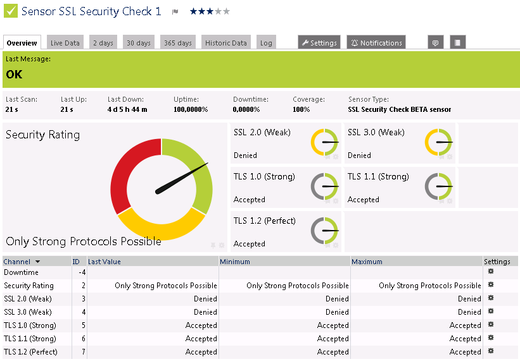Sensor of the Week: SSL Security Check Sensor
 Originally published on January 12, 2015 by Florian Staffort
Originally published on January 12, 2015 by Florian Staffort
Last updated on March 03, 2022
•
7 minute read
If you think back and try to remember the events that have been influencing your company's IT over the last few months, how many of them were security-related? After Heartbleed and POODLE it's on everybody's agenda to keep their SSL certificates up-to-date. As a PRTG Network Monitor user, you can now easily check the SSL connectivity to your devices' ports with the new SSL Security Check sensor.
The SSL Security Check sensor tries connecting to the specified TCP/IP port number of a device with various SSL/TLS protocol versions and shows if a particular protocol is supported:
- SSL 2.0: weak security (warning if accepted, up if denied)
- SSL 3.0: weak security (warning if accepted, up if denied)
- TLS 1.0: strong security (up if accepted, otherwise gray)
- TLS 1.1: strong security (up if accepted, otherwise gray)
- TLS 1.2: perfect security (up if accepted, otherwise gray)
In the default primary channel "Security Rating" you can see the connection security to the defined port at a glance. The following states give you an indication about the protocol's strength:
- Down: No secure protocol is available; the sensor cannot connect with one of the given protocols.
- Warning (weak): The sensor can connect with at least one of the weak protocols SSL 2.0 or 3.0.
- Up (strong): The sensor can connect with a strong protocol only (TLS 1.0, TLS 1.1, TLS 1.2); connecting with a weak protocol is not possible.
Although it should not be replacing other measures of security, the SSL Security Check sensor can help you gain an overview of the types of SSL connections that are accepted by your devices' ports.
This sensor type is currently in beta status. For more information on its development and individual sensor settings, please refer to the SSL Security Check sensor page of the PRTG manual.
All Sensors of the Week
You have missed other articles of our "Sensors of the Week" blog series? Just take a look at the last 10 sensors:
- Passive Application Performance sensor
- Hyper-V Host Server sensor
- SSH Script sensor
- QoS (Quality of Service) Round Trip sensor
- Windows Last Update sensor
- NetFlow V5 sensor
- SSH VMware ESX(i) Disk sensor
- SNMP Trap Receiver sensor
- SSH Meminfo sensor
- WMI Microsoft SQL Server sensor
Subscribe to our RSS feed to always stay up to date on new articles!









